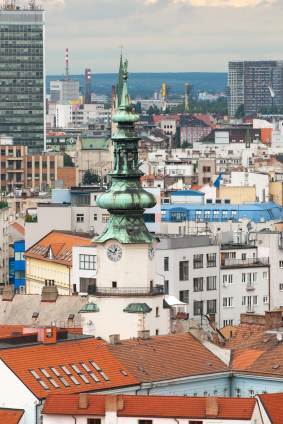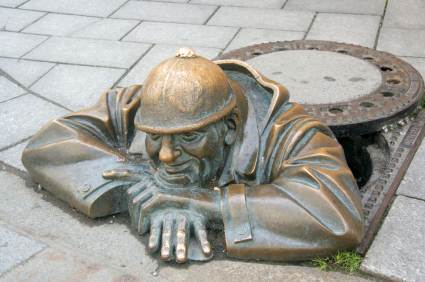|
|
March 30, 2011
Slovakia, Part 1

Bratislava, Slovakia
An interesting though not scintillating city,
housing about a tenth of Slovakia's five million people. It's a
hodgepodge of Slavic and Austro-Hungarian influences plus residual
Communist architecture. Advertised as one of Europe's youngest
capitals, Bratislava is certainly on an upswing. The road from the
airport sports an unbroken arcade of billboards which then gives way to
busy suburbs. The older neighborhoods are cleaner and neater than
Poland last year or the Czech Republic two years ago. The newer
neighborhoods have clusters of construction cranes poking above the
buildings like giant yellow storks.
Then: crossing the Danube into Bratislava, formerly
named Pressburg, the occasional home of the Austro-Hungarian monarchy,
where Hungarian kings were crowned for 300 years and was, more
recently, a part of the former Czechoslovakia. A large castle oversees
the city from a sudden hill above the Danube. The sizable Old Town that
winds down from the castle is easy to navigate and feels lived in.
Bratislava is a former market town and commercial crossroads.
The architecture here is mainly Austro-Hungarian
with hints of Art Deco although not as much as Prague or Budapest.
There are quirky little touches like the bronze sculptures in the
streets – a man with binoculars peeking around a building; another
bronze of a guy arising out of a sewer manhole, his chin resting on the
street with a contented half-smile on his face. Some locals claim he is
looking up women's dresses but Sewer Guy's eyes are fixed straight
ahead rather than up. He's an ankle fetishist, not an upskirter.

Outside of Bratislava’s old town you see the
Communist influence right away. There are more Soviet style buildings
than I've seen in other East European cities. Maybe they were
consciously showcasing for the West – Vienna is only 40 miles away –
but it’s like they branded every body part of the city with an ugly
tattoo. The buildings are usually painted a washed-out dark tan, with
lots of blocky windows and an occasional stab at abstract decoration –
say a George Braque-like cluster of brown rectangles. The net effect,
almost certainly intentional, is faceless, imposing and foreboding.
Three of these buildings surround an unkempt park
which in turn houses a large peculiar fountain. It is not in use
because of cost but the center piece of the fountain is a big silver
something – it is vaguely floral or it could be a smashed open clove of
garlic. But mostly it looks like a giant claw holding a steel ball in
its palm. The fountain's water comes out of the ball. Maybe the
claw-flower will crush the ball? Later I read in my guidebook that it
is supposed to be a Linden flower.
It could be my imagination but I keep seeing stylish
new buildings positioned near the Communist ones as if in blunt
rebuttal. There is a small skyscraper near the claw-flower park that is
not only handsome but occupies most of a city block. It looks like a
battleship and snugly hugs the corner, sure of itself. It is not
defiant, just firm; it’s saying "that's quite enough, we're taking over
now." I seem to see this dialogue all over town. |
|
|
|
Products
* About
* Enneagram
* Ericksonian
Hypnosis
Join Our
Mailing List
|
|
We
will notify you of new blog posts, upcoming product specials
as well as
new podcasts, workshops, CDs,
videos and books.
|
|
|